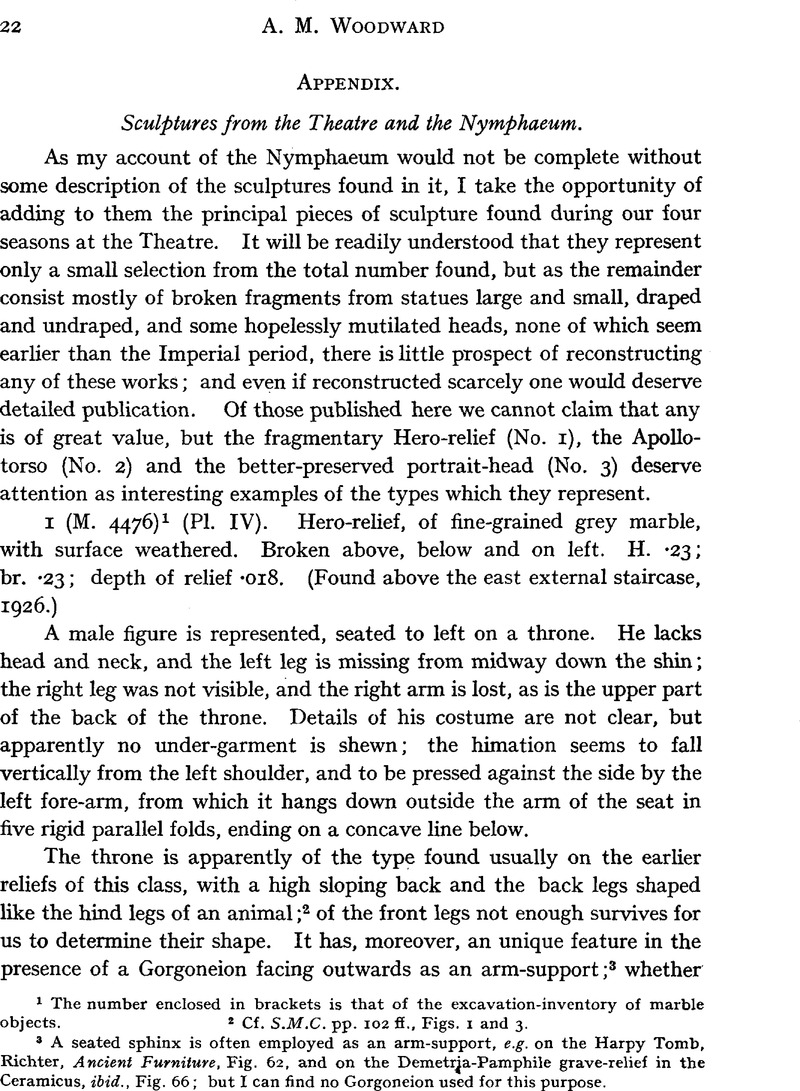No CrossRef data available.
Article contents
Excavations at Sparta, 1927: Appendix: Sculptures from the Theatre and the Nymphaeum
Published online by Cambridge University Press: 11 October 2013
Abstract

- Type
- Other
- Information
- Copyright
- Copyright © The Council, British School at Athens 1927
References
page 22 note 1 The number enclosed in brackets is that of the excavation-inventory of marble objects.
page 22 note 2 Cf. S.M.C. pp. 102 ff., Figs. 1 and 3.
page 22 note 3 A seated sphinx is often employed as an arm-support, e.g. on the Harpy Tomb, Richter, Ancient Furniture, Fig. 62, and on the Demetria-Pamphile grave-relief in the Ceramicus, ibid., Fig. 66; but I can find no Gorgoneion used for this purpose.
page 23 note 1 Richter, op. cit., pp. 45 ff.
page 23 note 2 S.M.C. Fig. 1; cf. also S.M.C. 505, Fig. 10.
page 23 note 3 S.M.C. p. 105, Fig. 6.
page 23 note 4 Op. cit. p. 10, note 3.
page 23 note 5 For the relation of these reliefs to other works of archaic Spartan art see Langlotz, , Frühgriechische Bildhauerschulen, pp. 90 ffGoogle Scholar.
page 25 note 1 The locus classicus for this statue is Lucian,Anacharsis, c. 7, καὶ τὸ ἄγαλμα δὲ αὐτου̑ ὁρα̢̑ς, τὸν ἐπὶ τη̣̑ στήλη̣ κεκλιμένον, τη̣̑ ἀριστερα̣̑ μὲν τὸ τὸξον ἔχοντα, ἡ δεξιὰ δὲ ὑπὲρ τη̑ς κεφαλη̑ς ἀνακεκλασμένη ὥσπερ ἐκ καμάτου μακρου̑ ἀναπαυόμενον δείκνυσι τὸν θεὸν.
page 25 note 2 Apollon, pp. 212 ff., Class X. e, 1. For the other version cf. also Furtwängler, , Masterpieces, p. 337Google Scholar, note 2; for another replica, from Gortyn, , Mon. Ant. xviii. p. 256 fGoogle Scholar. and Fig. 34.
page 25 note 3 The drawings in Creed's description of the Pembroke collection (published in 1731) are shewn reversed; cf. Michaelis, p. 665.
page 25 note 4 In his catalogue of the Glyptothek.
page 26 note 1 In this connection it is worth calling attention to the Laconian coin-type of Claudius, which I have not found published, with the Emperor's head sometimes to r., sometimes to l., and as reverse Apollo standing with r. arm on his head and l. resting on a column. The l. arm seems to hold a cloak, but the legs are crossed. (Two examples were found on the Acropolis, one at the Theatre.) In the circumstances this could hardly be meant to represent our statue.
page 28 note 1 Nuovo, Braccio, Amelung, , Cat. I. 124Google Scholar and Pl. 20.
page 28 note 2 Caskey, , Cat. of Gr. and R. Sculpt. No. 134Google Scholar.
page 28 note 3 Sala degli Imperatori, 70; cf. Die Antike, II. Pl. 6.
page 28 note 4 Cf. Strong, E., Roman Sculpture, p. 374 fGoogle Scholar.
page 28 note 5 Cortile, 2; Conservatori Cat., ed. Jones, H. Stuart, Pl. IGoogle Scholar.
page 28 note 6 Galleria, 19; op. cit. Pl. XXX.
page 28 note 7 Die Antike, II. Pl. 9.
page 28 note 8 For discussion of later Imperial portraiture see, in addition to Mrs. Strong's Roman Sculpture, Riegl's, paper, in Strena Helbigiana, pp. 250 ff.Google Scholar, and Kaschnitz-Weinberg, G., Spätrömische Porträts, Die Antike, II. pp. 36 ffGoogle Scholar. with admirable illustrations.
page 30 note 1 There is a certain resemblance to the Boston Balbinus (v. supra, p. 28, note 2), but not close enough to make the identity at all probable.
page 31 note 1 Compare the long series of female statues of the Imperial age reproduced in Reinach, , Rép. ii. pp. 665 ff.Google Scholar; most of these have the right hand exposed, but vary little in essentials from our example. Of similar statues in the Sparta Museum, S.M.C. 443 and 616 shew a bolder and more effective handling of the drapery, No. 709 is on about the artistic level of our example.
page 31 note 2 Cf. p. 5 f.
page 33 note 1 Reinach, , Rép. ii. p. 714Google Scholar.
page 33 note 2 Sala degli Animali, 212; a small and rather mild beast.
page 33 note 3 A suggestion for which I am indebted to Professor Droop.
page 35 note 1 Giardino, 101.
page 35 note 2 S.M.C. 442a, 442b; B.S.A. xii. p. 412Google Scholar, Fig. 2.
page 35 note 3 Perhaps this is a reminiscence of the Elis coin-type, Seltman, , Temple Coins of Olympia, p. 42 and Pl. iv. BNGoogle Scholar; Gardner, P., Types of Greek Coins, Pl. viii. 22Google Scholar. Seltman dates it ca. 432–ca. 421.
page 36 note 1 Cf. Richter, op. cit., p. 44, for this type on vase-paintings. In any case, when made of marble, owing to its cumbrous nature it must always have been more of a ‘fixture’ than a piece of domestic furniture.




